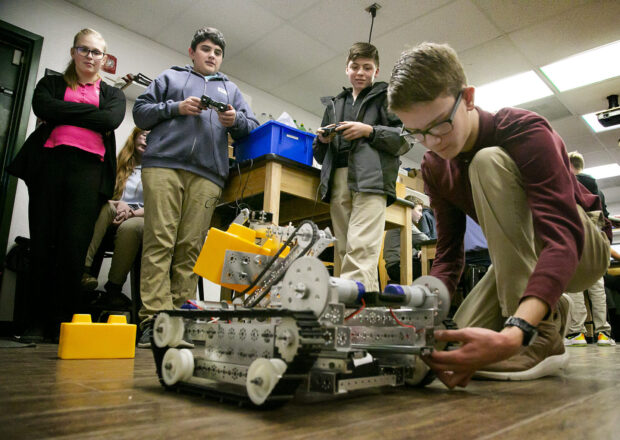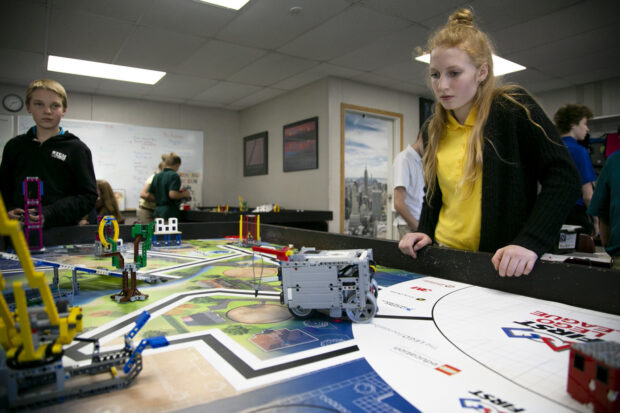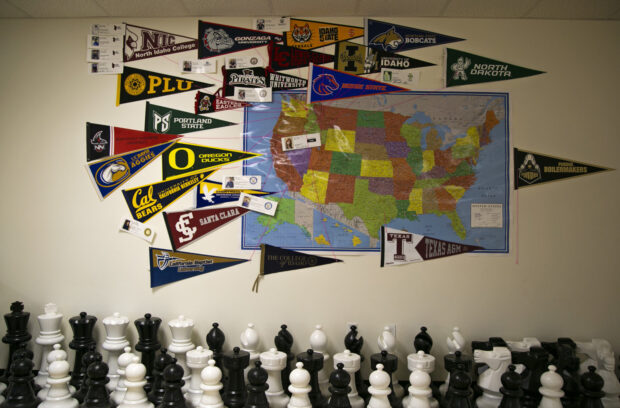RATHDRUM — The test scores at North Idaho STEM Charter Academy are almost as high as the standards.
Last year, the STEM students outperformed Idaho’s average on standardized tests by 30-40 percent in English, math and science. More than 90 percent of K-3 students finished last year reading at grade level. And the school is designated as a “top performer” and “goal maker” by the State Department of Education.
Founder Scott Thomson said the school doesn’t have any complicated recipe for success. The STEM and project focused school puts class time at a premium and asks students and teachers to hold themselves accountable for meeting expectations.
“In many ways it’s just that simple: Having high standards and sticking to them,” Thomson said.
Accountability is the cost of attendance at the free public charter school. For some, it can be a tough pill to swallow.
North Idaho STEM has no late-start times or early pickup days. The school doesn’t use intercoms, so as not to interrupt teachers, and hosts maybe one 15-minute assembly each year.

Students get no points for late homework, no weighted G.P.A.’s, no excused absences for family vacations and don’t move onto the next grade level if they’re not prepared. They stick to a dress code and go to school eight hours a day, four days a week.
“Our job isn’t to make you happy 10 days from now, it’s to make you happy 10 years from now, so you can have the skills you need to make a living,” Thomson said. “You can’t do that if you don’t teach [students] work ethic. And work ethic is showing up on time, dressed for success and turning in complete work, and following directions.”
Thomson and his wife Colleen, both long-time educators in the Lakeland school district, opened North Idaho STEM Charter Academy in 2012 to expand project-based education in the area.
At Lakeland, the pair had been hosting after-school projects for students, including the Mars Rover engineering project through Idaho TECH.
Instead of offering this program to Gifted and Talented students, Thomson and his wife opened the group for a dozen-or-so kids who didn’t qualify for the gifted program but showed good work ethic.
“The kids did great, and we said, you know all kids should have this opportunity,” he said.
At STEM Charter Academy, all kids do projects as part of the daily routine.
On a recent visit, seventh graders programmed robots to complete autonomous tasks, and high-schoolers built larger bots designed to stack blocks.
 Darlene Frates, a fourth-grade teacher at STEM Charter Academy, has been at the school since it first opened. One of the best things about it, she said, is that students who wouldn’t normally test into gifted or advanced programs have the same opportunity to tackle projects.
Darlene Frates, a fourth-grade teacher at STEM Charter Academy, has been at the school since it first opened. One of the best things about it, she said, is that students who wouldn’t normally test into gifted or advanced programs have the same opportunity to tackle projects.
“There are kids that thrive at this, who would not be in those programs other places,” she said. “Maybe they don’t test well, or they’re not as articulate or the way they shine is different. Here, that’s not a factor.”
While the school has a strong STEM focus (in fact, in 2018, STEM Charter Academy graduates were the first to graduate with an Idaho STEM diploma), not everything is about engineering. On a recent Wednesday, grade school students practiced reading aloud to their class, music students played ukulele’s and elementary kids broke up the day with basketball and frenzied playtime outside.
Since opening in 2012, STEM Charter Academy has expanded to serve 550 kids in kindergarten through 12th grade, with demographics that are similar to the nearest school district. About 90 percent of students at both STEM Charter Academy and the Lakeland school district are caucasian, and over 30 percent are low-income. In 2019, low-income students and non-low income students had very similar outcomes on standardized tests, bucking a statewide trend.
Graduates of STEM Charter Academy’s first graduating class had good things to say about the school, as do officials from the U.S. Department of Education. Jim Blew, an Assistant Secretary for Planning, Evaluation and Policy Development praised the school in a blog for the department.
“Perhaps the most impressive function of this curriculum is what it teaches outside of the STEM fields,” Blew wrote. “While students learn about STEM through these projects they also learn about problem solving, creative thinking and teamwork.”

The strict standards do come with a tradeoff. Especially in the first few years, Thomson said, some students and parents were not happy with the policies around things like no late work.
Some of that frustration plays out in online reviews. One anonymous parent wrote earlier this month that their son, a former straight A student, was failing classes at STEM charter. Now back at a traditional public school, the boy is back to A’s and B’s.
Thomson sticks by his standards. He says the school has a re-enrollment rate higher than 96 percent in the last three years, an indication that most parents and students see the value as well.
“You need to stick with your mission,” Thomson said. “Some people will like you and some people won’t, and that’s what school choice is all about.”

